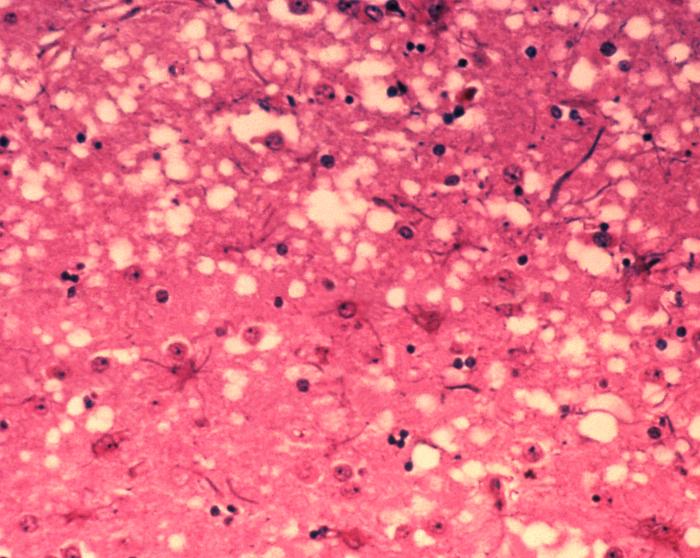As I wrap up my paradigm shift essay, which explores the ways in which inventions such as pasteurization have allowed for a decrease in the spread of milk borne pathogens, my mind is on cattle. However, this isn’t entirely unusual for me; my grandfather is a farmer, so cows have played an abnormally active role in my life.

To keep with the theme of bovine-related diseases, I thought that it would be interesting to delve into an illness that isn’t spread via milk, but rather, meat. In particular, I’d like to cover Bovine Spongiform Encephalopathy (BSE), more commonly known as “Mad Cow” disease.
The disease is caused by agents called prions; other, related illnesses include Creutzfeldt-Jakob Disease (aka CJD, which occurs in humans) and Chronic Wasting Disease (which infects deer and other related species).
Prions are essentially infectious misfolded proteins that lead to the production of more misfolded proteins (in particular, they lead to abnormalities in normal “prion proteins,” which are commonly found in the brain). As the number of abnormal proteins gradually accumulates, brain damage occurs, resulting in death. This damage, which leads to formation of small holes in the brain, gives BSE its name; the result is that the brain appears sponge-like (hence “spongiform encephalopathy”).

In recent history, the most notable outbreak of BSE occurred in Britain. Starting in 1986, incidences of the disease among the livestock populations gradually increased in frequency. As the cause of the cattle’s illness was identified, the country made efforts to mitigate the impact on the public (for example, consumption of brain tissue was banned).
While the initial mindset was that humans weren’t at risk of infection, this was disproved by the mid-1990s, when cases of a new variant of CJD (vCJD) were diagnosed and linked to the consumption of infected meat. Compared to the classic form, this new disease had slightly different clinical features and a different genetic profile in the prion protein gene. Additionally, unlike the classic form, it was communicable (whereas the vast majority of classic CJD cases are due to sporadic mutations).
By 2004, 143 people in Britain had been infected with vCJD. Over the course of the outbreak, 4.4 million cattle were slaughtered to end the spread of the disease. Not only were the events tragic for the livestock populations, but for others in the agriculture industry; it is estimated that three British farmers per week committed suicide in 1996 due to the catastrophic impacts the disease had on them economically.
The events were devastating, and they prompted a range of additional safety measures that would allow for the currently low rates of both vCJD and BSE. The feed given to cattle has become far more regulated; for example, the FDA bans feeding certain animal products to livestock, and the USDA has implemented guidelines requiring the testing of cattle for BSE when they are brought across state lines. While the incidences of BSE in the United States have always been significantly lower than those found in the British outbreak, these regulations have played a major role in keeping them low.

While for many of us, BSE is no longer a true threat, it is important to consider the lessons that can be learned from it. The outbreak demonstrated that certain prion diseases are transmissible to humans from animals; this leads to the question of whether there should be concerns about other prion diseases such as Chronic Wasting Disease “spilling over” into humans. The disease also highlighted the potential risks of keeping large herds of livestock; not only does it allow for greater spread of illness, but it creates extreme economic reliance on livestock (which can be decimated by disease).
By keeping these lessons in mind and promoting healthy practices (both in caring for livestock and in choosing the foods we eat), we can ensure that the levels of BSE and vCJD stay low in the United States, and we can promote the well-being of animals and humans alike.
That being said: wash your hands, wear a mask, and have a great break! : )
.
References
Gambetti, Pierluigi. “Overview of Prion Diseases.” Merck Manual Professional Version, Merck and Co., July 2020, www.merckmanuals.com/professional/neurologic-disorders/prion-diseases/overview-of-prion-diseases. Accessed 14 Nov. 2021.
“Prion Diseases.” Centers for Disease Control and Prevention, U.S. Department of Health and Human Services, 18 Oct. 2021, www.cdc.gov/prions/index.html. Accessed 14 Nov. 2021.
“Timeline of Mad Cow Disease Outbreaks.” Center for Food Safety, www.centerforfoodsafety.org/issues/1040/mad-cow-disease/timeline-mad-cow-disease-outbreaks. Accessed 14 Nov. 2021.
I have noticed that many diseases come from plants and animals and while we are fairly safe from them now, once upon a time we had no idea such risk were possible. Whether diseases could come from new sources, hide in new way, or adapt in ways we don’t expect will be crucial in maintaining future health. To me the lesson learned here is that it is important to always be on the forefront of research so we can stop diseases before we have to suffer the consequences.
I am very aware of how rare this disease is, but it is still super scary to me. Someone’s mother from my high school had contracted the illness and passed away. This was a very rare occurrence but makes me pretty wary of it. I did not know about the economic impact this disease had on farmers until this blog. It is crazy to see how interconnected everything is in our world and how fast things can go bad when one event happens.